
A new facility for the Materials Research Center for Element Strategy (MCES), informally called the Genso Cube (genso meaning "element" in Japanese), started operations at Tokyo Tech's Suzukakedai Campus on June 3, 2015. Materials and Structures Laboratory Professor Hideo Hosono heads MCES as its director. Hosono invented IGZO-TFT, an oxide semiconductor suitable for driving liquid-crystal panels and organic electroluminescent displays, and an iron-based superconductor, a discovery which has countered conventional wisdom. MCES was established in August 2012 to conduct research for the benefit of society through the creation of innovative materials using elements with high Clarke[1] numbers, in other words, those abundant in Earth's crust.
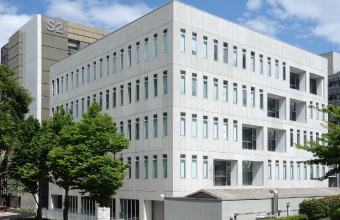
Exterior of the Genso Cube
As its nickname suggests, the Genso Cube has a cubical design, and is fitted with special equipment for high-precision experiments. The building features a transmission electron microscope (TEM) and an electron probe micro-analyzer on the basement floor, a lecture room seating 129 people on the 1st floor, joint research laboratories for companies and external research institutions on the 2nd floor, and laboratories for Tokyo Tech researchers on the 3th, 4th, and 5th floors. It is highly regarded as an open global research base by researchers both at home and abroad. "We want to conduct research that will defy conventional wisdom on elements," Hosono explains. In order to do so, the director has focused his efforts on achieving results that lead to industrialization, creating new materials science trends, and constructing an environment that facilitates the development of excellent researchers.
Young researchers invited by Hosono are also involved in projects here. Three of them were asked for their thoughts on element strategy research, the Genso Cube, and the development of research professionals.
Creation based on unconventional concepts
Research at the Genso Cube strives for practical applications.
How do you emphasize this in your research?
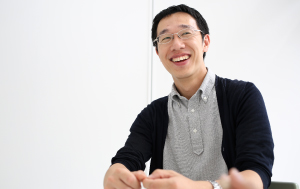 Satoru Matsuishi
Satoru Matsuishi
Research fields
Inorganic materials, physical properties,
applied physical properties
Profile
- 2013Associate Professor, Materials Research Center for Element Strategy (MCES), Tokyo Institute of Technology
- 2009Assistant Professor, Materials and Structures Laboratory, Tokyo Institute of Technology
- 2007Assistant Professor, Frontier Research Center, Tokyo Institute of Technology
- 2005Postdoctoral Researcher, Frontier Collaborative Research Center, Tokyo Institute of Technology
- 2005Doctor of Engineering, Department of Materials Science and Engineering, Interdisciplinary Graduate School of Science and Engineering, Tokyo Institute of Technology
- 2000Bachelor of Engineering, Department of Inorganic Materials, School of Engineering, Tokyo Institute of Technology
Matsuishi: I have been involved in the creation of electride compounds[2] for ten years. I also conduct research on iron-based superconducting substances, and am currently looking at hydrogen. Using hydrogen as a negative ion in materials can improve superconducting performance and add new functions.
As for practical applications, we are prone to think of joint research with companies. However, I am dealing with a broader concept — I am applying unconventional concepts to create new substances that benefit the betterment of society in general, for instance in terms of energy issues. Cement, an oxide composed of calcium, silicon, and aluminum, is a good example. It has been thought that oxides composed of typical elements whose atomic numbers are low do not allow electricity to pass through them. However, looking at the crystal structure of cement, it should conduct electricity regardless of its constitutional elements. This concept allows us to discover new electrides.
Tada: My role is to search for new materials using computer simulations, discover new functions, and create new concepts that allow us to clarify phenomena which, at first glance, look complicated. In the search for electrorides, we make use of a materials database based on electronics structure calculations to find the composition ratios and structures of positive and negative ions for electrides. In this way, we can identify potential candidates for electrides in terms of energetical stability.
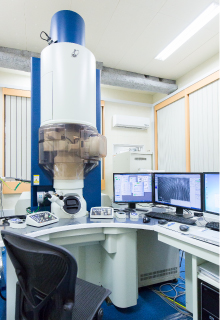
Transmission electron microscope
station in the Genso Cube
Although computational simulations are executable even for hypothetical compounds, researchers and companies engaged in materials synthesis and catalytic applications with the goal of commercialization insist on cost-effectiveness and environmental consciousness. It was tough at first to adjust and design our calculations from this viewpoint because I did not have ideas regarding the requirements that experimental researchers consider of the highest importance. However, as I experienced many difficulties in true materials designing that cannot be acquired through computer simulations only, I realized the importance of adopting a broader perspective.
Kitano: I am mainly involved in researching whether the electrides mentioned by Dr. Matsuishi can be developed and applied to catalytic reactions. While social need is important, I have realized, upon looking back on my discovery of potential ammonia synthesis using an electride with greater performance than that of conventional catalysts, that we should look beyond merely satisfying a need.
A major method for synthesizing ammonia, the Haber-Bosch process[3], was established 100 years ago, and researchers involved in the development of catalysts have not seen a need to replace it with other methods. We presented a completely different concept for ammonia synthesis using an electride catalyst. Many companies asked us to expand the use of this method for other applications rather than just using it as a replacement synthesis method. Through this, I realized that involvement in new materials and catalysts, and the dissemination of such information, can create new needs. In the case of joint development, companies sometimes tell us that methods reported in academic papers may not be applicable in commercialization. Therefore, flexible thinking is required.
Bringing in ideas from researchers in different fields
What kind of thinking is required to achieve effective breakthroughs
in materials science research and to create new trends?
 Masaaki Kitano
Masaaki Kitano
Research fields
Catalysts, resource chemical processes
Profile
- 2013Associate Professor, Materials Research Center for Element Strategy (MCES), Tokyo Institute of Technology
- 2009Assistant Professor, Materials and Structures Laboratory, Tokyo Institute of Technology
- 2007Postdoctoral Fellow, Solid Acid Ecocatalyst Project, Kanagawa Academy of Science and Technology
- 2006Postdoctoral Fellow, Organization of University-Industry-Government Cooperation, Osaka Prefecture University
- 2006Doctor of Engineering, Department of Materials Science and Engineering, Graduate School of Engineering, Osaka Prefecture University
- 2001Bachelor of Engineering, Department of Applied Chemistry, School of Engineering, Osaka Prefecture University
Kitano: Researchers tend to focus on their own specializations, but we also get information from people in different fields. An example of this is Dr. Tada's simulations suggesting the possibility of producing new materials. Conversations with Dr. Matsuishi often spark completely new ideas and perspectives on data that previously looked mediocre to me. I carry high hopes that this interaction will lead to significant breakthroughs in the future.
When we use electrides as catalytic material, for example, we immobilize metal nano-particle catalysts on the surface. Metal nano-particles are immobilized in a dispersed state with a general method used by researchers engaged in catalyst research. However, the electride catalyst prepared by this method did not perform at all as expected. If I had been the only one involved in the research, I would have concluded that the electride could not be used as a catalyst. However, by using a scanning tunneling microscope (STM)[4] and other devices, the Hosono group had already clarified that the maintenance or destruction of the electride surface structure (cage-like structure) significantly affects electrical conduction characteristics. This helped us to discover that immobilizing metal nano-particles without destroying the surface structure significantly improves catalytic performance.
The group consists of researchers specializing in a wide range of fields. I believe that listening carefully to their ideas and applying them to our research will spark new ideas.
Matsuishi: Researchers specializing in different fields have different ways of thinking. For example, researchers looking at catalytic reactions handle agents, which we generally think are dangerous, without any problems. Computational models of physical properties, which I personally think are difficult, may not be a problem for researchers who are familiar with the proper models. Before we collaborate with companies, it is important for us to collaborate with other researchers at Tokyo Tech.
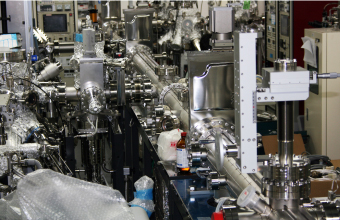
Thin-film synthesis and characterization equipment
Tada: Materials are of course directly connected to our daily lives. Taking advantage of new materials for home appliances and clothing can change our lifestyle drastically. In addition to the motivation to discover new materials, collaboration with other researchers can free us from our own limiting thoughts, leading to a broadened viewpoint and new directions in the search for materials, and in turn providing strength in our search for a breakthrough.
Attractive research naturally develops researchers
What do you think about developing young researchers as leaders,
and the stimulus you get at MCES?
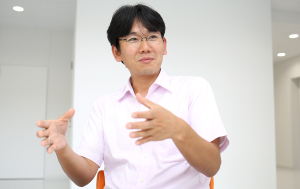 Tomofumi Tada
Tomofumi Tada
Research fields
Quantum chemistry, electronic structure theory,
computational materials designa
Profile
- 2013Associate Professor, Materials Research Center for Element Strategy (MCES), Tokyo Institute of Technology
- 2012Project Associate Professor, Department of Materials Engineering, Graduate School of Engineering, University of Tokyo
- 2011Project Lecturer, Department of Materials Engineering, Graduate School of Engineering, University of Tokyo
- 2004Assistant Professor, Department of Materials Engineering, Graduate School of Engineering, University of Tokyo
- 2003Postdoctoral Fellow, Institute for Materials Chemistry and Engineering, Kyushu University
- 2002Postdoctoral Fellow, Institute for Fundamental Research of Organic Chemistry, Kyushu University
- 2002Doctor of Science, Department of Chemistry, Graduate School of Science, Hiroshima University
- 1996Bachelor of Science, Department of Chemistry, Faculty of Science, Hiroshima University
Tada: Professor Hosono is a strong distinguished leader. From his leadership, I recognized that, when many researchers having similar or different viewpoints are engaged in a project as a team, it is necessary to find areas of focus and create a big flow that absolutely leads to a successful goal.
In addition, it is also necessary to maintain a positive motivation to continue the same research. The strong support by Professor Hosono also helps us to keep this motivation. I, therefore, need to find my own ways of advancing my research and maintaining a motivating environment for younger researchers. This is essential in encouraging the next generation.
Kitano: What I have learned from my experience is that everyone should struggle with adversity. I want to emphasize this to my students. When I was engaged in joint research with Professor Hosono as an assistant professor, I was becoming desperate working on a project for one month without any results. The professor was stern. "That can't be right. Keep working and you will succeed," he said. This changed my attitude and helped me to continue. And three months later, I achieved results.
If we engage in enjoyable and attractive research, we improve ourselves naturally. The director often reminds us of this. Following my research interests has made me what I am. I will pass this down to the next generation.
What has changed after your move to Genso Cube?

Night view of the Genso Cube
Matsuishi: Opportunities for exchanging ideas with researchers beyond the boundaries of individual fields have increased significantly. When students working with superconductive materials measure physical properties, they often use existing measuring devices rather than creating their own. On the other hand, in the research on catalysts that Dr. Kitano is involved in, they start by processing the glass and metal they will be working with. It is a great environment for both researchers and students to see the process of development from the beginning in neighboring laboratories.
Tada: In this new building, students in our laboratory enjoy their research life in the student room of the Hosono Laboratory, allowing them to come into contact with hot information and topics. It is an excellent environment for young theoretical researchers and students. Although the amount of information they obtain may sometimes be overwhelming, it is definitely a great experience for their development in the long run.
Materials are the key to fundamental breakthroughs in
science and technology
The public have great expectations for MCES.
What do you think MCES should be?
Kitano: The Hosono Group has achieved many innovative results in materials research. Therefore, the public is always looking forward to their next innovation. I also feel the pressure of such expectations. However, it is natural for people to have great expectations for our research as what we are doing is discovering new methods in the field of science. I appreciate having such an excellent environment to conduct research in. My hope and aspiration is the creation of new catalyst materials based on original concepts.
Tada: Materials informatics[5], a state-of-the-art approach in computational materials exploration, has attracted much attention around the world. MCES is required to show a successful strategy of computational materials science for the discovery of new materials.
The Genso Cube exhibits an excellent function that allows us to carefully analyze the simulation results by comparing them with experimental data by other researchers. Everyone can share the progress and results of their research at the Genso Cube at any time.

Multi-floor stairwell inside the Genso Cube
Matsuishi: The number of laboratories that deal with substance synthesis has been decreasing in every country. Some experiments carry life-threatening risks if we make mistakes. However, we do not shrink away from such risks. Instead, we do our best to ensure safety by simulating experiments, and we continue working toward our goal of creating new materials.
I have synthesized new materials. However, I often doubted their usefulness. Although I was involved in the synthesis of electrides, I could not connect their application to ammonia synthesis. However, I also realize that attempting to synthesize materials with the aim of producing something useful alone is not enough to make a scientific discovery. It is always essential to think about development and use together. This is materials development that truly considers function. New materials are those that lead to fundamental breakthroughs in a wide range of scientific fields. The Genso Cube has the human resources and facilities needed to produce such new materials.
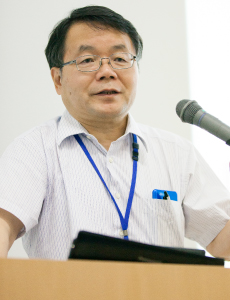
Present and future of materials development
Hideo Hosono
Founding Director, Materials Research Center
for Element Strategy (MCES)
Ever-expanding possibility of a small rock
Japan is strong in material development and still at the world's top level. However, no one can guarantee that Japan will be in the current position after three years. There are few researchers who are seeking new materials from their heart. Many people think that there is little room for expansion, but this is not true. If you take a careful look underneath, you can find a lot of undiscovered materials. The field of materials is fertile for such discovery.
Working together under one roof
People inspire people. We are not inspired only by others' research papers. We are inspired by our five senses. It is extremely important for us to feel that we will be able to achieve. People are not improved by others. People, who are capable of being improved, improve. The most important thing in the drive to improve ourselves is to find opportunities and environments where we are inspired by others. The Genso Cube is excellent in this sense because all of us here have similar spirit and ambition.
(Extracted from the keynote lecture at MCES opening ceremony on June 3, 2015)
Explanations of Technical Terms
1. Clarke
American geochemistry pioneer Frank Wigglesworth Clarke (1847-1931) first examined the chemical composition of rocks in Earth's crust. Russian geologist A.E. Fersman continued the study of elements in the crust, and proposed that the numbers used to represent the quantities of elements be named "clarkes" to honor the American. Elements with high Clarke numbers are abundant, while those with low ones are rare.
2. Electride compounds
Compounds in which electrons serve as anions. The first room temperature stable electride was realized using an alumina cement ingredient, 12CaO·7Al2O3.(C12A7). Utilizing the characteristics of chemical inertness and thermal stability of the C12A7 electride, and electrons that emit easily, it is applied to high-functional catalysts and electronic materials, and has the potential of being capable of solving food and energy issues, and contributing broadly to a highly information-based society.
3. Haber-Bosch process
A representative ammonia synthesis method utilizing nitrogen and hydrogen on an iron-based catalyst at high pressure of 200-300atm and 400-600°C. Developed by Professor Fritz Haber at the Karlsruher Institute of Technology in 1906, and industrialized by Carl Bosch, BASF engineer in 1913.
4. Scanning tunneling microscope (STM)
This microscope makes it possible to bring a conducting tip very near to the surface or surface-adsorbed molecules of conductive substances, and observe the condition and structure of electrons at the atomic level from the resulting tunneling current. It was developed by Gerd Binnig and Heinrich Rohrer in 1982.
5. Materials informatics
This is a method of innovative materials development through the analysis of accumulated data in materials science utilizing computers and networks. This method is expected to be effective for reduction of the research period from materials discovery to practical application to half.
The Special Topics component of the Tokyo Tech Website shines a spotlight on recent developments in research and education, achievements of its community members, and special events and news from the Institute.
Past features can be viewed in the Special Topics Gallery.
. Any information published on this site will be valid in relation to Science Tokyo.














